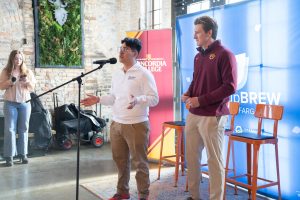What would the ultimate video gaming room look like? It would have to start with at least a 42” flat-screen TV. There would have to be a surround sound system with Dolby 5.1 audio. Oh, and of course every video game console since the Nintendo Entertainment System. A room just like this exists right here in Moorhead, but its residents are doing much more than just playing video games.
Concordia juniors Joseph Gilmore and David Sparer have started programming and developing their own video game. As computer science majors at Concordia, they both have done a final project for their Computer Science 225 course. Sparer, who took the class a semester before Gilmore, created a very simple turn based, role playing game for computer. For his final project, Gilmore took this game and fixed some of the bugs, making it run smoother. They had gotten their feet wet in this project, so now they were ready to jump in and create a full-length computer game.
At the off-campus house of Gilmore and Sparer, on top of a small wooden entertainment center sits the 42” flat screen TV and the tall gray speakers of the surround sound right beside it. Jammed inside the entertainment center are all of Gilmore’s video game consoles: a NES, Super NES, Sega, Nintendo 64, Nintendo Wii, Playstation 2, Playstation 3 and an Xbox 360. On the wall beside this massive collection is a six-by-three-foot DVD rack filled with close to 200 video games, but this gaming room does not stop there. In the corner of this large room sits a white kitchen table which acts as their computer work/gaming station. Two massive black computer towers are under the table, both custom built by Sparer. These two roommates have their laptops here as well, along with two 22” monitors, a 18” inch monitor and 20 computer games.
All of this, thousands of dollars of video gaming equipment, has lead to countless hours of time spent playing all of the 200 games that used to sit on store shelves, but now Gilmore and Sparer want to try something different. They are going to look at video games from the other side of the store shelf by making their own game.
Gilmore and Sparer sit in their gaming room. Gilmore is on the red plaid couch opposite the TV. He is playing “Call of Duty: Black Ops,” the sounds of gunfire and grenade explosions blasting from the speakers. Every time his character dies during game play, Gilmore shouts insults at the TV. Sparer sits in front of his two computer monitors. He is playing “World of Warcraft” on the one monitor, the other displays his Facebook page. Not a sound comes from him unless prompted with a question. They both explain how they have been into video gaming since they were little kids.
“My dad got me into video games when I was only five or six,” Gilmore said. “He was a musician, so I would play Super Mario Bros. while he wrote music. When I got to a hard level I couldn’t beat, he would play then.”
Gilmore received his very first gaming console, a Sega, along with Sonic the Hedgehog from his father for his sixth birthday. From there on out, he was a gamer. If he was not hanging out with friends or playing guitar, he could most likely be found in his room with a controller in his hand playing Mega Man or Banjo Kazooie. It wasn’t until the sixth grade, however, that he stepped into the realm of PC /computer gaming.
“It was about a year after Blizzard released Starcraft for the PC when I actually got it. My friends had been playing this and other computer games so I wanted to get into it,” Gilmore said.
Even in these early years of playing computer games, Gilmore was trying to create games within Starcraft.
“My friends and I tried to create a chess game mode [in Starcraft] with the level editor, having certain rules about moving our armies around the custom maps we made,” Gilmore said. “It didn’t quite work. Our armies that we moved ended up taking out more than they were supposed to for each move and lots of times took out the king when they shouldn’t have.”
While Gilmore had been late to discovering PC gaming as a child, Sparer started out playing video games on his computer rather than on a video game counsel. Sparer turns from his larger computer screen and takes off his headset, disconnecting him from the chat lobby of other gamers he had been playing online with.
“Me and my dad would play first-person shooter games on his computer when I was really young. He would do almost all of the controls on the keyboard to move the character and I would press the space bar to shoot,” Sparer said.
All of his early gaming was done on the computer, one of the reasons he got into programming.
He started playing more in-depth strategy games. This boosted his interest in how computer games ran and how they came to be games. In the eighth grade, Sparer asked his parents to buy him a programming software so he could start learning about the world of computer programming.
“My parents got me this programming language called Visual Basic. I started programming crappy little programs that would print text to the screen and then write it backwards,” he said.
Although nothing special came from Sparer’s Visual Basic programming, he continued. He took a C++ programing class in high school (C++ being a type of programming language), which lead to him getting an internship at Medtronic, a medical technology company. He worked on designing Web pages for Medtronic’s research and development program.
Both Gilmore and Sparer, natives of Anoka, Minn., enrolled at Concordia in the fall of 2008. They each had their minds set on pursuing music degrees. After a semester of music classes, Sparer decided that a music career was not for him. He decided to change his academic goals to computer science.
“I knew I liked programming and I had the background. Once I took CSC [computer science] 125 , I was like, ‘Yeah, this is what I want to do,”’ Sparer said.
Gilmore needed a math class for his generals, so in his sophomore year, he took CSC 125 with Professor Jonathan Pikalek.
“The first week of class I knew I wanted to do this [programming],” Gilmore said. “I still wanted to do music, and I had already taken the majority of the core music classes so I am double majoring in music and computer science.”
Professor Jonathan Pikalek of the computer science department was excited to hear about his students taking on this challenge. The book shelves on the wall of his office are filled with rows of programming text books, several of them with titles related to programming video games such as The Black Art of 3D Game Programming, by Andre Lamothe.
“It always impresses me when a student takes some concept or lesson outside of the classroom and does something with it. The fact that they [Gilmore and Sparer] are doing something game related is awesome,” Pikalek said. “Programming video games is not an easy task.”
Pikalek has approached Gilmore and Sparer with the possibility of using their game for more than their own entertainment.
“Once they [Gilmore and Sparer] have completed most of their game, it is a possibility that they can turn it into an undergraduate research project through the college,” Pikalek said. “A lot of work will have to go into the game.”
Pikalek himself grew up playing video games and started learning about programming in high school. In college he worked with programming research for the Department of Defense, designing simulation software and has done work with game programming. He always works to share his interest and enthusiasm in programming with students by finding out what they want to do with programming.
“If you have three 70-minute conversations each week, and they like a topic, wouldn’t they want to talk about it?” Pikalek said.
Now Gilmore sits opposite of Sparer at their computer table. Both of them have the programming software C# open on their computer screens. Their screens are full of lines of code typed into C#. They have pages of design philosophy and pseudo-code (descriptions of code and how it will work once it is put into programming software) written in Microsoft Word. All this and the game does not have any animation or user interaction yet.
“Game programming is hard,” Sparer said. “If you mess up one tiny thing, it could mess up a big chunk of the game, if it even runs.”
It takes a line, if not 100 lines of code, to be able to control an action seen in a game or to make animations and scenery in the game.
“The general consumer [of video games] thinks that creating a small change in a game takes a few clicks of the keyboard on the programmers part and it is done, but that is not how it works,” Gilmore said.
“Yeah, consumers usually think that the programmer has to type their ideas into the computer and a game will appear,” Sparer said. “Programmers have to pay attention to every detail and there are so many rules with programming and we need to know those rules.”.
Sparer is not sure what he will want to pursue with his computer science degree. He is leaning more towards a career in an area of higher demand for programmers, but this project is still fun for him. Gilmore knows he will be pursuing game programming.
“I love playing video games so I figure why not program them for a living,” he said. “This project will be something to start a portfolio for when I look for jobs too.”
Even though there is a lot of work that still needs to be done, these programmers are confident that they will have the game completed before they graduate. Next year, when Gilmore and Sparer are sitting at their computer table, they will be playing their new game, Gilmore yelling every time his character dies and Sparer sitting quietly on the other side of the table.




Be First to Comment